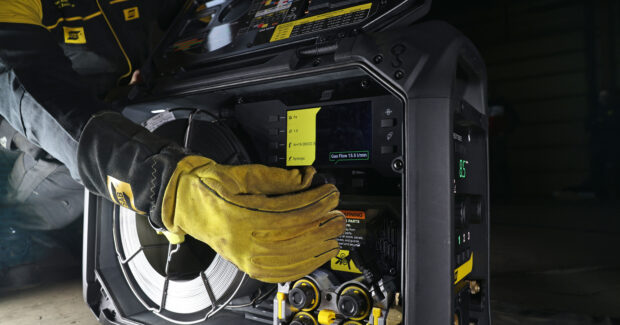Improving Shielding Gas Flow Control in Wire Welding Applications
Ensuring consistency and saving money across a weld fleet has never been easier.
Posted: April 29, 2024
While shielding gas adds just a few cents to each meter of weld, who wouldn’t want to reduce shielding gas costs by up to 20%, or about $1,000 annually per machine? Who wouldn’t want to eliminate the downtime and hassle of swapping cylinders? Most importantly, who wouldn’t want to eliminate a root cause of porosity and the cost associated with weld defects?
New digital gas control technology incorporated in select brands of wire feeders delivers the peace of mind that comes from using each liter of gas in accordance with weld procedure specifications. Digital control provides a level of precision, confidence and savings not previously possible with single-stage external pressure regulation devices and standard wire feed units.
Instead of a standard On/Off solenoid valve with Open/Closed positions, these feeders use a proportional flow valve that provides variable control. The proportional control mechanism incorporates two sensors: a differential pressure sensor that regulates gas flow rate in liters (or cu. ft.) per minute and an absolute pressure sensor determines the mass flow rate. Combined, they can precisely and rapidly control gas flow.
 As shown in the figure above, digital gas control reaches the set flow rate faster and ensures an accurate flow rate. Conversely, standard technology systems greatly overshoot, then take more than five seconds to reach the set value. Additional benefits of digital controls include the ability to:
As shown in the figure above, digital gas control reaches the set flow rate faster and ensures an accurate flow rate. Conversely, standard technology systems greatly overshoot, then take more than five seconds to reach the set value. Additional benefits of digital controls include the ability to:
- Regulate flow to the correct rate independent of cylinder pressure or gas flow restrictions, which preserve weld integrity as cylinders run low.
- Eliminate the need to calibrate the system upon first use.
- Eliminate the need to recalibrate the system when switching torches or changing gas mixes, increasing uptime.
- Eliminate shielding gas surge when trigger is initially pulled.
No Surge
To appreciate the benefits of digital gas control, start with one of the biggest problems it solves: gas surges. That “whooshing” sound at arc start is the sound of losing money. As shown in the chart below, a standard regulator and wire feeder can waste 1.8 liters per arc start (especially with long gas hose lengths, according to tests conducted at ESAB’s Gothenburg, Sweden facilities). Conversely, digital gas control virtually eliminates waste.
 While wasting gas is annoying, gas surges may also have a hidden cost: porosity at the start of the weld.
While wasting gas is annoying, gas surges may also have a hidden cost: porosity at the start of the weld.
A gas surge during arc starts creates turbulence that pulls air into the shielding gas flow. Unfortunately, some operators mistakenly believe insufficient gas flow caused the porosity, so they increase flow rates to a point where they compound contamination problems. In addition to porosity at the beginning of the weld, excess gas flow may cause random porosity along the weld seam.
The good news about digital gas control is that fabricators do not need to do anything special. With a synergic line (factory optimized programs), the system may have an optimized flow rate as a default. If the operator wants to adjust flow, the digital controls make it easy — and if the welding supervisor wants to set limits and lock gas flow, they can do that too. Also, digital data monitoring, tracking and analyzing apps that can transmit real-time data to a phone, tablet or computer are available. Ensuring consistency and saving money across a weld fleet has never been easier.
















